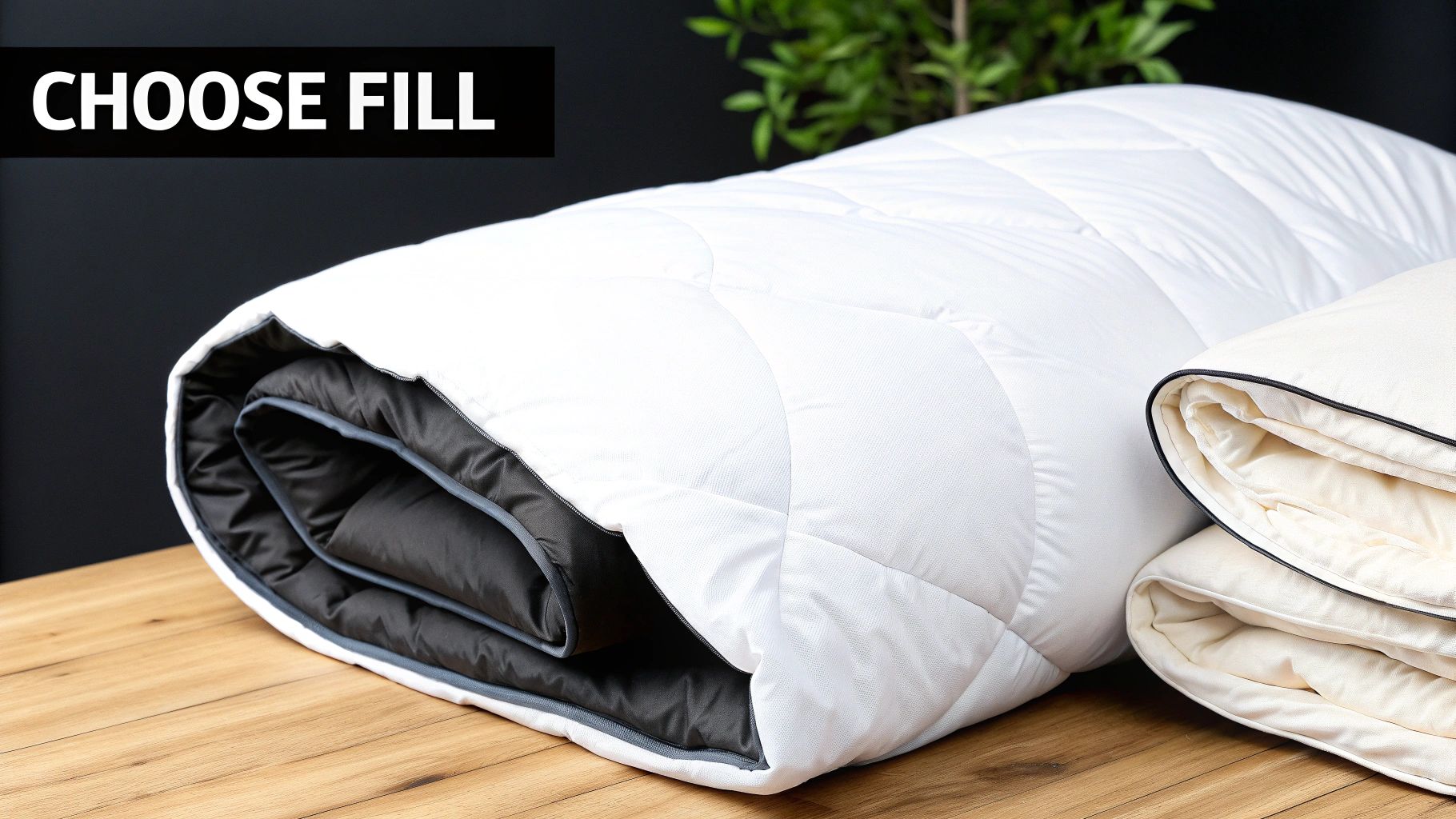Choosing the right duvet covers queen size is about much more than just picking a colour you like. It’s really about matching the fabric to your personal comfort and, just as importantly, to the New Zealand climate. The goal is to find that sweet spot between breathability for our humid summer nights and a cosy feel for when the southerly blows through.
How to Choose Your Ideal Queen Duvet Cover
Finding that perfect queen duvet cover can genuinely transform your bedroom. Think about it – it's the largest piece of fabric in the space, so it really sets the tone. But it’s not just about looks; the right cover can make a world of difference to how well you sleep. The trick is to look beyond the latest trends and zero in on what truly matters: the material, the weave, and the little details in its construction.
Start with the Right Material
Your choice of fabric is easily the most important decision you'll make. Here in New Zealand, with our temperate climate, natural fibres like linen and high-quality cotton are fantastic all-rounders.
- Linen: If you're a hot sleeper, linen is your best friend. It’s incredibly breathable and has a beautiful, relaxed look that just gets softer and more inviting with every wash.
- Cotton: A true classic for a reason. Cotton comes in different weaves – percale is that crisp, cool feeling like a freshly laundered shirt, whereas sateen feels much silkier and a bit warmer.
- Poly-blends: These are usually easier on the wallet, but they often can't compete with the breathability of natural fibres. If you find yourself getting too warm at night, a synthetic blend might be trapping heat.
Choosing the right material for our variable Kiwi weather is key. To make it a bit easier, here’s a quick rundown of the most common options.
Queen Duvet Cover Material Comparison for NZ Climates
| Material | Best For | Feel | Care Level |
|---|---|---|---|
| Linen | Year-round comfort, hot sleepers, humid climates | Soft, textured, relaxed, gets softer over time | Easy |
| Cotton Percale | Those who love a crisp, cool hotel-bed feeling | Light, crisp, and matte | Medium |
| Cotton Sateen | A touch of luxury, cooler sleepers | Silky, smooth, with a subtle sheen | Medium |
| Bamboo | Eco-conscious shoppers, sensitive skin | Extremely soft, smooth, drapes beautifully | Delicate |
| Poly-blend | Budget-conscious buyers, kids' rooms | Can vary; often smooth but less breathable | Very Easy |
Ultimately, the best material is the one that feels right for you and suits the way you sleep.
Look Beyond the Weave
We've all heard the term thread count, and it's often thrown around as the ultimate measure of quality. But honestly, it can be a bit misleading.
A lower thread count in a premium, long-staple cotton will feel miles better and last much longer than a ridiculously high thread count in a cheaper, short-staple cotton. So instead of getting fixated on the number, pay more attention to the type of fibre and its weave.
A well-made 300-thread-count percale cover often feels more luxurious and holds up better than a 1000-thread-count cover made from inferior cotton. It’s always quality over quantity when it comes to the yarn itself.
The Finishing Touches Matter
Finally, don’t forget the practical details – they can make or break your experience. The type of closure is a big one. Buttons can look lovely and add a classic, cottage feel, but they can be a bit fiddly. A good quality zipper, on the other hand, gives a clean, modern look and makes changing the duvet cover a breeze.
Another small feature that makes a massive difference is internal corner ties. These little fabric ties allow you to secure your duvet inner, stopping it from bunching up inside the cover. It’s a game-changer!
Here in New Zealand, the queen size is by far the most popular choice, making up about 45% of household beds. This popularity has led to a real shift in what people are looking for, with a clear trend showing 60% of consumers now prioritising sustainable and eco-friendly textiles for their bedding. You can learn more about NZ bedding trends and fabric preferences to see what's driving these choices.
Getting the Measurements Right for a Perfect Fit
There’s nothing worse than a duvet cover that just doesn’t fit properly. If it’s too snug, the inner gets all bunched up and lumpy. Too baggy, and it looks messy and slides around. The secret is to look beyond the "queen" label on the package, as the actual dimensions for duvet covers queen size can differ quite a bit from one brand to another.
Your best bet? Grab a measuring tape and get the exact dimensions of your duvet inner. Just lay it out flat on your bed or the floor and measure its width and length. This is a non-negotiable step because the loft—how fluffy your inner is—really affects the fit. A plush, high-loft feather inner needs more space to breathe than a thinner, synthetic one.
Beyond the Basics of Bedding Size
For that truly luxurious, hotel-worthy look, you also need to think about how far you want the duvet to drape over the sides of your bed. This means you’ll have to consider your mattress depth.
Measure from the top of your mattress down to the top of your bed base or frame. If you have a particularly deep mattress, you'll want a wider duvet to get that elegant overhang. Otherwise, it can look a bit short and unfinished. For a full rundown of standard NZ dimensions, check out our handy guide to duvet cover sizes.
My Pro Tip: When you’re shopping for a linen duvet cover, always add at least 5cm to your inner’s measurements. Linen has a beautiful, relaxed quality, and that little bit of extra room allows it to drape naturally without looking strained or tight.
If you're really into the details of textiles and want to understand the material side of things, learning how to calculate fabric yardage can offer some interesting insights into how these pieces are constructed.

Ultimately, getting the right duvet cover boils down to a few key decisions. As the infographic shows, you're balancing the fabric itself, its specific weave, and the type of closure you prefer. Each of these elements plays a part in the final look, feel, and functionality of your bedding.
Matching Your Duvet Inner to Your Cover
The look of your duvet covers queen size is only half the story. The inner you slip inside really dictates the feel, the warmth, and the overall shape it takes on your bed. This pairing is what truly creates your ideal sleep setup, because different fills work with linen in completely different ways.
If you’re dreaming of that billowy, cloud-like bed you see in magazines, a high-loft down or feather inner is your secret weapon. It completely fills out the linen, giving it a plush, full-bodied volume that just begs you to jump in. This is the go-to combination for anyone wanting a truly luxurious, cosy vibe.

On the other hand, a more streamlined synthetic inner, like one filled with microfibre, creates a crisp, modern silhouette. You get all the warmth without the puffiness, which results in a flatter, more tailored finish. This look is perfect for minimalist or contemporary bedrooms where clean lines are key.
Natural vs Synthetic Fills
The choice between natural and synthetic fills really boils down to what you prefer in terms of weight, warmth, and the final look you're after.
- Natural Fills (Down & Feather): These are famous for their amazing insulation and breathability. Light and airy down clusters are brilliant at trapping heat while letting moisture escape—a must-have for New Zealand's changeable climate. Plus, they deliver that incredible loft for a fuller-looking bed.
- Synthetic Fills (Microfibre & Polyester): A fantastic hypoallergenic option, synthetic inners are often easier on the wallet and simpler to care for. They'll keep you perfectly warm, but they tend to be less breathable than their natural cousins.
It's no surprise that natural fills like down are the most popular choice worldwide, making up about 62% of the duvet market back in 2022. We see that same preference here in New Zealand, where the breathability of natural materials is a perfect match for our moderate temperatures.
Think of it this way: choosing an inner isn't just about function, it's a design choice. The inner is the hidden ingredient that brings the personality of your linen duvet cover to life, whether that’s opulent comfort or clean, modern lines.
If you're leaning towards the sumptuous feel of a natural fill, a premium down duvet inner is the perfect place to start your journey to a hotel-quality bed at home.
Styling Your Bed Like a Professional
Think of your new duvet cover as the foundation for your entire bedroom's vibe. It’s the largest single piece of fabric in the room, so it naturally sets the tone. Styling your bed is all about taking that foundation and building on it to create a space that feels personal, comfortable, and inviting. The real trick is in layering textures and playing with proportion.

Your duvet covers queen size is the canvas. From there, you can add layers to create visual depth and a touch of luxury. You don't need a mountain of cushions to get it right; often, just a few thoughtful additions make all the difference.
Master the Art of Layering
The secret to that plush, 'jump-right-in' look you see in magazines? It's all about creating depth with different textures and shapes. A well-layered bed just looks so much more inviting.
- Pillows Are Everything: Don’t just throw your two sleeping pillows on top. Start by propping two large, square Euro pillows against the headboard. They create height and act as a perfect backdrop for everything else.
- The 'Karate Chop' Trick: Want that perfectly plumped, designer cushion look? It's simple. Hold the cushion upright and give it a firm chop down the centre with the side of your hand. This creates that inviting dimple that instantly makes it look more luxe.
- Throw on Some Texture: A chunky knit or a soft waffle throw blanket draped casually across the foot of the bed is a game-changer. It adds a completely different texture and is a brilliant way to introduce an accent colour without overwhelming the space.
Choosing Your Colour Story
The colours you choose will dictate the whole mood of the bedroom. If you're after a calm, serene retreat, a monochromatic or analogous scheme is your best bet. Think about using different shades of the same colour, or colours that sit right next to each other on the colour wheel, like soft blues with gentle greys.
But if you want something a bit more dynamic, it's all about contrast. A neutral linen duvet cover is the perfect base for bold, vibrant cushions in a completely different shade. A deep emerald green cushion against a natural oatmeal linen duvet, for instance, creates a really stunning focal point.
A great rule of thumb I always come back to is the 60-30-10 principle. Your duvet cover makes up the dominant colour (60%), your pillows are the secondary shade (30%), and a throw or a small cushion provides that final pop of accent colour (10%).
Keeping Your Duvet Cover Looking Its Best
A beautiful linen duvet cover is a real investment in your comfort, and with just a little care, you can protect its softness and keep its colour looking rich for years to come. The right approach ensures your **duvet covers queen size** won't just last—they'll actually get better with every wash.The secret is to always be gentle. I recommend using a mild, liquid detergent and steering clear of harsh chemicals like bleach, which can be brutal on natural linen fibres. Washing in cold or lukewarm water on a gentle cycle is the safest bet to protect the fabric's integrity and avoid any unwanted shrinkage.
Washing and Drying Best Practices
Proper laundering is everything when it comes to linen. It’s not just about getting it clean; it's about bringing out its best natural qualities.
- Don't Overcrowd the Machine: Your duvet cover needs space to move around freely. This ensures a proper clean and stops the fabric from getting twisted or stretched out of shape.
- Keep the Heat Low: When tumble drying, always stick to a low heat setting. High heat can make linen brittle. A great trick is to pull it out while it's still slightly damp and let it finish air drying.
- Skip the Fabric Softener: Here's the good news—linen softens naturally over time. Fabric softeners actually coat the fibres, which can reduce their wonderful absorbency and breathability.
If you want to dive deeper, our detailed guide on washing and caring for luxury European linen has even more tips.
A simple tip I swear by is line drying your linen whenever possible. It's not just about saving power; the fresh air and sunlight naturally brighten whites and leave your bedding smelling incredible.
When a spill happens, the key is to act fast. Blot the stain straight away (never rub!) and treat it with a gentle stain remover before popping it in the wash.
For storing your duvet cover between seasons, make sure it's completely clean and dry first. Then, pack it away in a breathable cotton bag and keep it out of direct sunlight. Following this simple routine will ensure your favourite bedding remains the centrepiece of your room for years.
Got Questions About Queen Duvet Covers? We've Got Answers
When you're ready to invest in beautiful, high-quality bedding like a queen duvet cover, it's natural to have a few questions. Getting the details right from the start is the key to choosing something you'll absolutely love sleeping in for years.
Let's walk through some of the things we get asked most often.
What Size is a Queen Duvet Cover in NZ?
This is probably the number one question people have. In New Zealand, a standard queen duvet cover is typically 210cm x 210cm.
However, you'll find slight variations from brand to brand. That's why I always tell people to measure their actual duvet inner before buying a cover. It’s a simple step that guarantees you get that perfect, inviting drape over the sides of your bed instead of a fit that’s too snug or too loose.
How Often Should I Be Washing It?
To keep your bed feeling fresh and hygienic, a good rule of thumb is to wash your duvet cover every one to two weeks.
If you have allergies or a furry friend who loves to nap on your bed, you might want to stick to a weekly wash. This simple routine not only keeps things clean but also helps preserve the beautiful quality of the linen itself.
Here's the best part about linen: it genuinely gets softer and more beautiful with every wash. So, regular, gentle cleaning isn't just about hygiene—it's what makes your bedding feel even more luxurious over time.
This focus on quality care makes sense, especially as Kiwis are investing more in their sleep environments. The New Zealand bedding market is actually expected to hit around US$63.87 million by 2025. A big driver for this is the convenience of online shopping, which now makes up about 35% of all bedding sales. You can read the full research about NZ bedding market trends to see how our habits are changing.
Do I Really Need to Iron My Linen Duvet Cover?
In a word: no! One of the most beautiful things about pure, airo-washed linen is its naturally relaxed, slightly rumpled texture. It's meant to look effortless and inviting, not stiff and pristine.
My best tip? Once it's out of the dryer or off the line, just give it a good, firm shake before putting it on the bed. This will smooth out any major creases and let that gorgeous, soft texture shine.
Ready to find the perfect foundation for your sleep sanctuary? Explore our collection of luxurious, European linen duvet covers at The Foxes Den.


